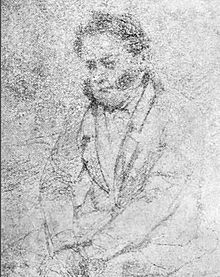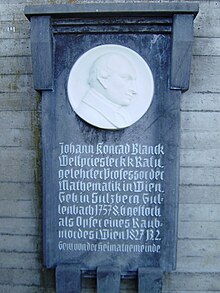Johann Conrad Blank
Johann Conrad Blank (born June 8, 1757 in Sulzberg (Vorarlberg) ; † February 13, 1827 in Vienna ) was an Austrian Abbé , kk councilor and mathematician , whose violent death caused a sensation in what was then Vienna.
Life
Youth, school, studies
Conrad Blank came from a Sulzberg farming family. His father Johann Michael was born in house no.83 in the Holderegg district and lived with his wife Magdalena Blank (née Steurer) in house no.68 in the Gullenbach district on the border with the Bavarian settlement of Eibele (Oberstaufen), the house where Johann was born Conrad became. Later the family moved to the neighboring hamlet in the Allgäu and lived there in the former Kellhof of the St. Gallen Monastery, today's Mangold House ( the priest and scholar Johann Konrad Blank lived here for some time ) p. 666 . Since Conrad spent his childhood here, Weiler became his second home, which he visited again and again.
The parents sent Johann Conrad to the grammar school in Weingarten Abbey after his first class . He then studied philosophy at the University of Innsbruck .
According to another source, Blank began the so-called humanior studies (Latin grammar, rhetoric and poetics) in Constance and completed it in Vienna with the Piarists in Josephstadt .
On p. 4 , this phase of life reads like this: Gymnasium zu Constanz with a degree from the Piarists in Vienna as well as studying theology and philosophy and studying mathematics.
With the Black Spaniards
In Vienna, Blank then succeeded in being accepted into the Benedictine order of Montserrat (popularly: "among the black Spaniards" ). He received in March 1782 page 4 the ordination , celebrated Sacrifice of the Mass , but also devoted himself with great zeal mathematical studies, which allowed him a new career with the resolution of the pen.
The Spanish Benedictine Congregation of Santa Maria de Montserrat built a monastery in the Alservorstadt (today Vienna IX. District) in the 17th century , which was destroyed again in 1683 during the Second Turkish siege of Vienna . The Spanish monks remained without a monastery and gathered in their church as the "Brotherhood of Eternal Virtue". The vernacular called them "Schwarzspanier" or "Schwarze Münich" because of their black religious dress and to distinguish them from the white-clad Trinitarians . However, the convent had to give up the facility again in the 18th century. The abbot and the remaining monks moved to the city in November 1779 to the former Jesuit college (now Vienna 1st district) and were integrated into the Schottenstift . In 1781 the former prelature building, the so-called Schwarzspanierhaus , was converted into a tenement house (today's address at Schwarzspanierstrasse 15). Ludwig van Beethoven later lived there from mid-October 1825 until his death on March 26, 1827. The building was replaced in 1904 by a new building. The adjacent Schwarzspanierkirche , the successor to the former monastery church, still exists today.
academy
After the dissolution of Schwarzspanierstrasse order Blank worked 1783 S. 4 initially as a Hofmeister (tutor) and received 1788 S. 5 employment as a cooperator (curate, Kaplan) in Altlerchenfeld . P. 692 Abbé Hofstetter recommended him as a professor of mathematics for the Theresian Knight Academy . When this educational institution passed to the Piarists , in 1805 he successfully applied for the mathematical chair at the School of Architecture p. 9 , a department of the Academy of Fine Arts headed by the court building officer and architect Peter von Nobile , which had become vacant due to the death of Franz Josef Beck Vienna pp. 135-136 . In 1807 he received the full professorship and became a member of the academic council p. 11 . From then on he called himself " Johann Conrad Blank, Abbe ", " Professor of Mathematical Sciences " and " Ordentlicher Rath ".
In the years from 1807 to 1812 Blank also gave lessons in the educational institute of the director Pleban in the Palais Sina (Hoher Markt No. 8), including Severin von Jaroszynski, who years later would become his murderer. P. 13
hamlet
Blank lived and worked in Vienna and did not let the ties with his Vorarlberg homeland be severed. There are indications of his support from relatives p. 217 and stays in his second hometown Weiler im Allgäu (neighboring community of his birthplace Sulzberg). There he is said to have visited the Gasthof Linde more often ( here in the 19th century important men came and went, such as Dr. Anton Schneider , the General Commissioner of Bregenz, the great scholar Konrad Blank, the legal scholar Dr. Alois von Brinz and the poet Hermann von Lingg . ) p. 654 .
Violent death
Johann Conrad Blank had provided for his old age with bank shares and bonds and deposited them with a friend to be on the safe side. Twelve years earlier, Blank taught mathematics at the Pleban private school in Vienna, among others, to a young nobleman named Severin von Jaroszynski (1789–1827) from the former Polish (now imperial Russian) Podolia . Jaroszynski, who came from a wealthy landowner family, had in the meantime made a career and started a family, but had fallen into deep debt due to his penchant for gambling. He fled to Vienna in mid-1826, acquired the title of count and found access to the so-called better society of Vienna through his urbane appearance and expensive invitations. His hopes for high game winnings quickly were not fulfilled and the cash he had brought with him was used up in a few months. When the government of his home country demanded his return because of his own demands, he tried to put an end to his financial embarrassment through a cold-blooded robbery of his former teacher, who is now almost 70 years old. The act was cleared up a few days later and Jaroszynski was executed after a trial on August 30, 1827 at the “New Vienna Gallows” on Wienerberg . The reporting on the crime, the investigation, the judgment and the execution attracted a great deal of attention in what was then Vienna.
Works
Blank wrote several popular textbooks and handbooks that are recommended for their clarity and thoroughness p. 692 . His textbook on arithmetic was introduced in kk grammar schools and was valued for its systematics and dry brevity.
List of all works by Blanks p. 24
- Instructions for mathematics first part, the special and general art of arithmetic. (Vienna 1800).
- The beginnings of the art of measuring . To the use of the kk Ther. Knight Academy in Vienna. (Vienna 1800).
- The beginnings of special and general arithmetic . (Vienna 1804).
- Complete foundations of general arithmetic . (Vienna 1809).
- Complete beginnings of the theoretical art of measuring , but without copper plates. (Vienna 1813).
- Complete beginnings of the conic sections . (Vienna 1814).
- Tables of logarithms and numbers, sines and tangents . (Vienna 1816).
- Complete beginnings of plane and spherical trigonometry . (Vienna 1818).
- Instruction on the methodical use of the foundations of arithmetic . (Vienna 1822).
- Elementa arithmeticae singularis et universalis . Instruction on the methodical use of the Elementa arithmeticae singularis et universalis for the humanitarian teachers in the grammar schools of the KK Austrian states, KK Schulb. Administration, (Vienna 1824) Entry in google-books .
Quotes about blank
Contemporaries describe Blank as a humble and kind person:
- As a person, Blank was a model of humility and kindness of heart p. 692
- elderly, venerable man […] in conversation benevolent and friendly […] It was said that he lived very frugally and thriftily; he probably collects for poor relatives. P. 217
- A gentle, pious disposition with a tendency towards the clergy, p. 223
literature
- Constantin von Wurzbach : Blank, Johann Conrad . In: Biographisches Lexikon des Kaiserthums Oesterreich . 1st part. University printing house L. C. Zamarski (formerly JP Sollinger), Vienna 1856, pp. 422–425 ( digitized version ).
- Carl Hofbauer: The Alservorstadt with the original possessions of the Benedictine abbey Michelbeuern on the wild stream Als. Verlag Leopold Sommer, 1861 online edition
- Gerhard Robert Walter von Coeckelberghe-Dützele: Curiosities and Memorabilia Lexicon from Vienna online edition
- Michael Kirchschlager: The girl murderer Hugo Schenk. Austria's big criminal cases. Verlag Kirchschlager, 2007, ISBN 978-3-934277-15-1 Online edition including the murder by Jaroszynski of Professor Blank on pp. 13–44.
- Elmar Holzer: Trade and Crafts In: The home book Weiler im Allgäu 894-1994. Holzer publishing house and printing company, Weiler im Allgäu, 1994.
- Poggendorf: Blank, Johann Konrad (1757–1827), mathematician and priest in ÖBL 1815–1950, Volume 1 (Lfg. 1, 1954), p. 91 ÖBL entry ° Short biography (PDF; 184 kB)
Web links
- Franz Joseph Weizenegger and M. Merkle (eds.): Vorarlberg, from the papers of the priest Franz Joseph Weizenegger Wagner'sche Buchhandlung, Innsbruck 1839 (First Chronicle of the State of Vorarlberg. Therein Konrad Blank in the section about Sulzberg)
- The Schwarzspanierhaus (house where Beethoven died) in the aeiou cultural information system
- Court and State Schematism of the Austrian Empire, Vienna 1822
- A look back at the past (Johann Conrad Blank) in: The Austrian Viewer, JS Ebersberg (Hrsg.): Vienna 1837
- Austrian observer on the crime committed against Johann Conrad Blank, Verlag Anton Strauss, Vienna 1827
- Death sentence of 1827
- Michael Kirchschlager: The girl killer Hugo Schenk: Austria's big criminal cases
- The very last meal; The robbery (radio play tips ORF)
- Vorarlberger Landesarchiv Rep 14-061 Stella Matunina manuscripts, manuscript 14: Diplomatar Vorarlberg 1630-1862, p. 28. (PDF; 217 kB)
- Johann Conrad Blank: Complete beginnings of the conic sections, etc , 1814 out of print
- Gerlinde Faustmann: Johann Konrad Blank , Vienna 2008 (PDF; 1.5 MB) life data on the German-speaking slide rule collector's website
Individual evidence
- ↑ a b c d e f g see web link Konrad Blank in Franz Joseph Weizenegger and M. Merkle: Vorarlberg, from the papers of the priest Franz Joseph Weizenegger, who died in Bregemz.
- ↑ see web link Vorarlberger Landesarchiv, Stella Matunina manuscripts
- ↑ a b see literature Elmar Holzer: Handel und Handwerk in: Das Heimatbuch Weiler im Allgäu 894-1994
- ↑ a b c d e f see literature Gerhard Robert Walter von Coeckelberghe-Dützele: Curiosities and Memorabilia Lexicon of Vienna
- ↑ a b c d e f g h see web link Gerlinde Faustmann: Johann Konrad Blank
- ↑ see literature Carl Hofbauer: The Alservorstadt with the original possessions of the Benedictine abbey Michelbeuern on the wild stream Als.
- ↑ see web link Das Schwarzspanierhaus (where Beethoven died) in the aeiou cultural information system
- ↑ a b c see web link Johann Conrad Blank in: The Austrian audience.
- ↑ see web link Court and State Schematism of the Austrian Empire.
- ↑ see web link Austrian observer about the crime against Johann Conrad Blank
| personal data | |
|---|---|
| SURNAME | Blank, Johann Conrad |
| ALTERNATIVE NAMES | Blank, Konrad |
| BRIEF DESCRIPTION | Austrian Abbé, kk councilor and professor of mathematics |
| DATE OF BIRTH | June 8, 1757 |
| PLACE OF BIRTH | Sulzberg (Vorarlberg) |
| DATE OF DEATH | February 13, 1827 |
| Place of death | Vienna |







